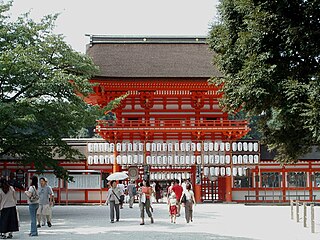
The Heian-jingu Shrine is a Shinto shrine located in Sakyō-ku, Kyoto, Japan. The Shrine is ranked as a Beppyō Jinja (別表神社) by the Association of Shinto Shrines. It is listed as an important cultural property of Japan.

Iwashimizu Hachimangū (石清水八幡宮) is a Shinto shrine in the city of Yawata in Kyoto Prefecture, Japan.

A Shinto shrine is a structure whose main purpose is to house ("enshrine") one or more kami, the deities of the Shinto religion.

Yasaka Shrine, once called Gion Shrine, is a Shinto shrine in the Gion District of Kyoto, Japan. Situated at the east end of Shijō-dōri, the shrine includes several buildings, including gates, a main hall and a stage. The Yasaka shrine is dedicated to Susanoo in the tradition of the Gion faith as its chief kami, with his consort Kushinadahime on the east, and eight offspring deities on the west. The yahashira no mikogami include Yashimajinumi no kami, Itakeru no kami, Ōyatsuhime no kami, Tsumatsuhime no kami, Ōtoshi no kami, Ukanomitama no kami, Ōyatsuhiko no kami, and Suseribime no mikoto.

Hirota Shrine is a Shinto shrine in Nishinomiya City, Hyōgo Prefecture, Japan. The town's name, "Nishinomiya", means "shrine of the west", and the town is named for Hirota Shrine.

Kamo Shrine is a general term for an important Shinto sanctuary complex on both banks of the Kamo River in northeast Kyoto. It is centered on two shrines. The two shrines, an upper and a lower, lie in a corner of the old capital which was known as the "devil's gate" due to traditional geomancy beliefs that the north-east corner brought misfortune. Because the Kamo River runs from the north-east direction into the city, the two shrines along the river were intended to prevent demons from entering the city.

The Twenty-Two Shrines of Japan is one ranking system for Shinto shrines. The system was established during the Heian period and formed part of the government's systematization of Shinto during the emergence of a general anti-Chinese sentiment and the suppression of the Taoist religion. It involved the establishment of the shrines as important centers of public life in Japan. It played a role in official imperial ceremonies such as the Practice of Chinkon. An extensive body of literature also emerged containing information about each shrine, including the shrine's origin, priestly dress, divine treatises, the system of shrine removal, subordinate shrines, and annual cycle of rituals, among others.

Matsunoo Taisha, formerly Matsunoo Jinja (松尾神社), is a Shinto shrine located at the far western end of Shijō Street, approximately 1.3 kilometers south of the Arashiyama district of Kyoto. It is home to a spring at the base of the mountain, Arashiyama, that is believed to be blessed.

A Hachiman shrine is a Shinto shrine dedicated to the kami Hachiman. It is the second most numerous type of Shinto shrine after those dedicated to Inari Ōkami. There are about 44,000 Hachiman shrines.

Kamigamo Shrine is an important Shinto sanctuary on the banks of the Kamo River in north Kyoto, first founded in 678. Its formal name is the Kamo-wakeikazuchi Shrine.

Shimogamo Shrine is an important Shinto sanctuary in the Shimogamo district of Kyoto city's Sakyō ward. Its formal name is Kamo-mioya Shrine. It is one of the oldest Shinto shrines in Japan and is one of the seventeen Historic Monuments of Ancient Kyoto which have been designated by UNESCO as a World Heritage Site. The term Kamo-jinja in Japanese is a general reference to Shimogamo Shrine and Kamigamo Shrine, the traditionally linked Kamo shrines of Kyoto; Shimogamo is the older of the pair, being believed to be 100 years older than Kamigamo, and dating to the 6th century, centuries before Kyoto became the capital of Japan. The Kamo-jinja serve the function of protecting Kyoto from malign influences.

The Katori Shrine is a Shintō shrine in the city of Katori in Chiba Prefecture, Japan. It is the ichinomiya of former Shimōsa Province, and is the head shrine of the approximately 400 Katori shrines around the country. The main festival of the shrine is held annually on April 14, with a three-day Grand Festival held every 12 years.

The Hokkaidō Shrine, named the Sapporo Shrine until 1964, is a Shinto shrine located in Sapporo, Hokkaido, Japan. Sited in Maruyama Park, Chūō-ku, Sapporo, Hokkaido, the Hokkaido Shrine enshrines four kami including the soul of the Emperor Meiji. A number of early explorers of Hokkaidō such as Mamiya Rinzō are also enshrined.

Nonomiya Shrine, or the Shrine in the Country, is a Shinto shrine in the Arashiyama district on the west side of the city of Kyoto, Japan, close to its bamboo forest. The specific site of the shrine has changed somewhat over time, as the location of the shrine was fixed anew by divination when a new imperial priestess was to undergo purification before traveling to take up her duties at Ise Shrine.

Ōmiwa Shrine, also known as Miwa Shrine, is a Shinto shrine located in Sakurai, Nara Prefecture, Japan. The shrine is notable because it contains no sacred images or objects, since it is believed to serve Mount Miwa, the mountain on which it stands. For the same reason, it has a worship hall, but no place for the deity to be housed. In this sense, it is a model of what the first Shinto shrines were like. Ōmiwa Shrine is one of the oldest extant Shinto shrines in Japan and the site has been sacred ground for some of the earliest religious practices in Japan. Because of this, it has sometimes been named as Japan's first shrine. Ōmiwa Shrine is a tutelary shrine of the Japanese sake brewers.

Tatsuta Shrine is a Shinto shrine located in Sangō, Nara in Japan. The shrine is also known in Japanese as Tatsuta-jinja (龍田神社).

Umenomiya Shrine is a Shinto shrine located in Ukyō-ku in Kyoto, Japan.

Niukawakami Shrine, also known as Nibukawakami Jinja, is a Shinto shrine located at Higashiyoshino in Nara, Japan.

Kamo Clan Information.



















